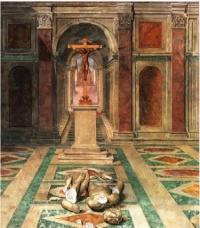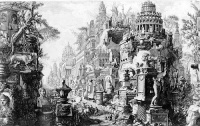Europe
From The Art and Popular Culture Encyclopedia
| Revision as of 09:39, 6 October 2013 Jahsonic (Talk | contribs) ← Previous diff |
Revision as of 09:40, 6 October 2013 Jahsonic (Talk | contribs) Next diff → |
||
| Line 24: | Line 24: | ||
| === By medium === | === By medium === | ||
| :''[[European cinema]], [[European music]], [[European art]]'' | :''[[European cinema]], [[European music]], [[European art]]'' | ||
| + | |||
| + | '''European art''' is the art of the [[Europe]]an countries, and art created in the forms accepted by those countries. | ||
| + | |||
| + | European prehistoric art started as mobile rock, and cave painting art, and was characteristic of the period between the [[Paleolithic]] and the [[Iron Age]]. | ||
| + | |||
| + | Written histories of European art often begin with the art of the [[Ancient Middle East]], and the [[Aegean civilisation|Ancient Aegean civilisation]]s, dating from the [[3rd millennium BC]]. Parallel with these significant cultures, art of one form or another existed all over Europe, wherever there were people, leaving signs such as carvings, decorated artifacts and huge standing stones. However a consistent pattern of artistic development within Europe becomes clear only with the art of [[Ancient Greece]], adopted and transformed by [[Rome]] and carried; with the Empire, across much of [[Europe]], [[North Africa]] and the [[Middle East]]. | ||
| + | |||
| + | The influence of the art of the [[Classical antiquity|Classical period]] waxed and waned throughout the next two thousand years, seeming to slip into a distant memory in parts of the [[Medieval art|Medieval]] period, to re-emerge in the [[Renaissance]], suffer a period of what some early art historians viewed as "decay" during the [[Baroque]] period, to reappear in a refined form in [[Neo-Classicism]] and to be reborn in [[Post-Modernism]]. | ||
| + | |||
| + | Before 1800s, the Christian church was a major influence upon European art, the commissions of the Church, architectural, painterly and sculptural, providing the major source of work for artists. The history of the Church was very much reflected in the history of art, during this period. In the same period of time there was renewed interest in heroes and heroines, tales of mythological gods and goddesses, great wars, and bizarre creatures which were not connected to religion. | ||
| + | |||
| + | [[Secularism]] has influenced European art since the Classical period, while most art of the last 200 years has been produced without reference to religion and often with no particular [[ideology]] at all. On the other hand, European art has often been influenced by politics of one kind or another, of the state, of the patron and of the artist. | ||
| + | |||
| + | European art is arranged into a number of stylistic periods, which, historically, overlap each other as different styles flourished in different areas. Broadly the periods are, [[classical antiquity|Classical]], [[Byzantine]], [[Medieval]], [[Gothic]] [[Renaissance]], [[Baroque]], [[Rococo]], [[Neoclassical]], [[Modern]] and [[Postmodern]]. | ||
| + | |||
| ==== European literature ==== | ==== European literature ==== | ||
| :''[[European literature]]'' | :''[[European literature]]'' | ||
Revision as of 09:40, 6 October 2013


Illustration: Antichita Romanae (1748) by Piranesi
|
Related e |
|
Featured: |
- “Heaven is where the police are British, the cooks are French, the mechanics are German, the lovers are Italian and the bankers are Swiss. Hell is where the police are German, the cooks are English, the mechanics are French, the lovers are Swiss, and the Italians the bankers”.
Europe is one of the world's seven continents.
Europe, in particular Ancient Greece and Ancient Rome, is the birthplace of Western culture. It played a predominant role in global affairs from the 16th century onwards, especially after the beginning of colonialism. Between the 16th and 20th centuries, European nations controlled at various times the Americas, most of Africa, Oceania, and large portions of Asia. Both World Wars were largely focused upon Europe, greatly contributing to a decline in Western European dominance in world affairs by the mid-20th century as the United States and Soviet Union took prominence.
Contents |
Culture
- European culture, Dead white European males - Eurocentrism - European culture - continental philosophy
The culture of Europe might better be described as a series of multiple cultures, often competing; geographical regions opposing one another, Orthodoxy as opposed to Catholicism as opposed to Protestantism as opposed to Judaism as opposed to Secularism as opposed to Islam; many have claimed to identify cultural fault lines across the continent. There are many cultural innovations and movements, often at odds with each other, such as Christian proselytism or Humanism. Thus the question of "common culture" or "common values" is far more complex than it seems to be.
Upon the pagan cultures of aboriginal Europe, the foundations of modern European cultures were laid by the Greeks, strengthened by the Romans, stabilized by Christianity, added to by the rest of Europe, reformed and modernized by the fifteenth-century Renaissance and Reformation, and globalized by successive European empires between the sixteenth and twentieth centuries. Thus the European Culture developed into a very complex phenomenon of wider range of philosophy, Judeo-Christian and secular humanism, rational ways of life and logical thinking developed through a long age of change and formation with the experiments of enlightenment, naturalism, romanticism, science, democracy, fascism, communism, and socialism. Because of its global connection, the European culture grew with an all-inclusive urge to adopt, adapt and ultimately influence other trends of culture. As a matter of fact, therefore, from the middle of the nineteenth century with the expansion of European education and the spread of Christianity, European culture and way of life, to a great extent, turned into "global culture," if anything has to be so named.
By medium
European art is the art of the European countries, and art created in the forms accepted by those countries.
European prehistoric art started as mobile rock, and cave painting art, and was characteristic of the period between the Paleolithic and the Iron Age.
Written histories of European art often begin with the art of the Ancient Middle East, and the Ancient Aegean civilisations, dating from the 3rd millennium BC. Parallel with these significant cultures, art of one form or another existed all over Europe, wherever there were people, leaving signs such as carvings, decorated artifacts and huge standing stones. However a consistent pattern of artistic development within Europe becomes clear only with the art of Ancient Greece, adopted and transformed by Rome and carried; with the Empire, across much of Europe, North Africa and the Middle East.
The influence of the art of the Classical period waxed and waned throughout the next two thousand years, seeming to slip into a distant memory in parts of the Medieval period, to re-emerge in the Renaissance, suffer a period of what some early art historians viewed as "decay" during the Baroque period, to reappear in a refined form in Neo-Classicism and to be reborn in Post-Modernism.
Before 1800s, the Christian church was a major influence upon European art, the commissions of the Church, architectural, painterly and sculptural, providing the major source of work for artists. The history of the Church was very much reflected in the history of art, during this period. In the same period of time there was renewed interest in heroes and heroines, tales of mythological gods and goddesses, great wars, and bizarre creatures which were not connected to religion.
Secularism has influenced European art since the Classical period, while most art of the last 200 years has been produced without reference to religion and often with no particular ideology at all. On the other hand, European art has often been influenced by politics of one kind or another, of the state, of the patron and of the artist.
European art is arranged into a number of stylistic periods, which, historically, overlap each other as different styles flourished in different areas. Broadly the periods are, Classical, Byzantine, Medieval, Gothic Renaissance, Baroque, Rococo, Neoclassical, Modern and Postmodern.
European literature
European literature refers to the literature of Europe.
European literature includes literature in many languages; among the most important are English literature, Spanish literature, French literature, Polish literature, German literature, Italian literature, Greek literature, Latin literature, Russian literature. In colloquial speech, European literature often is used as a synonym for Western literature. European literature is a part of world literature.
European art
European music
European cinema
By genre
Euro trash - European comics - European disco - European erotica - European exploitation (culture) - European horror
See also
- European tourism
- European stereotypes
- European wars
- United States of Europe
- A French satirical cartoon map of Europe in 1870


_-_B._Bellotto.jpg)


